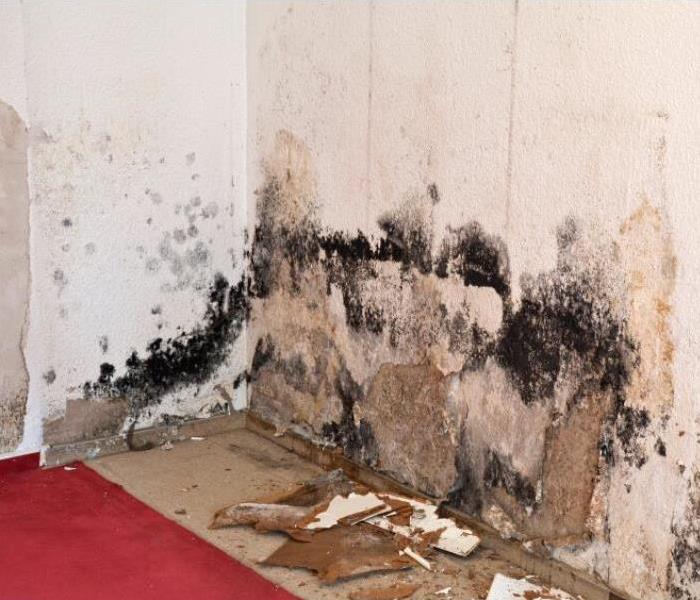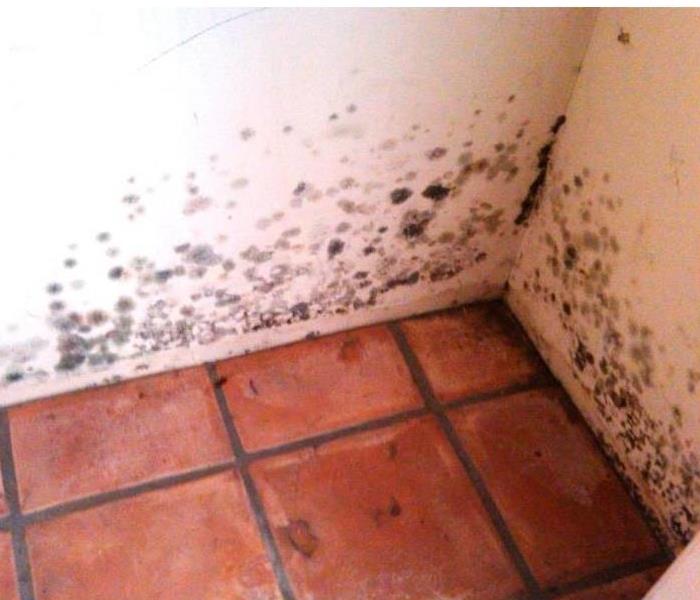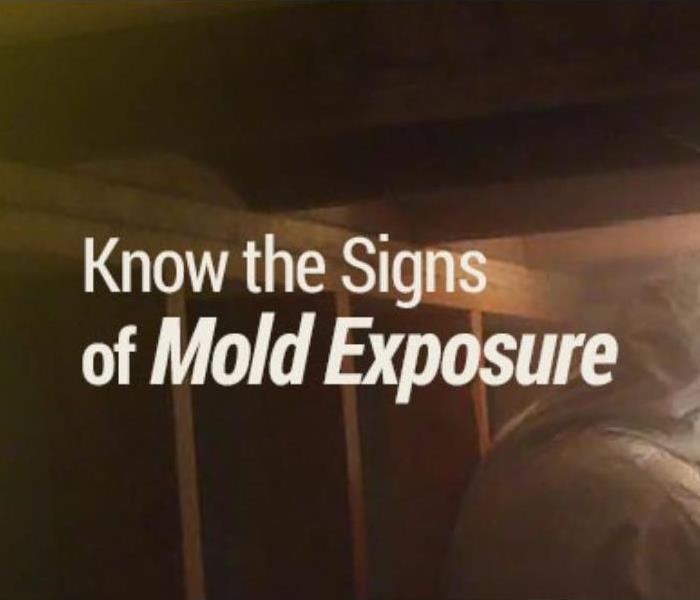Recent Mold Remediation Posts
The Importance of Professional Mold Remediation: Why DIY Isn't Enough
6/10/2024 (Permalink)
Mold can be a persistent problem in homes, especially after water damage. While DIY solutions might seem like a cost-effective approach, professional mold remediation offers several key advantages.
1. Thorough Inspection and Assessment
SERVPRO® professionals conduct a comprehensive inspection to identify all mold-affected areas. Mold can hide in places you might not consider, such as behind walls or under flooring. Our thorough assessment ensures that all mold sources are identified and addressed.
2. Advanced Equipment and Techniques
SERVPRO uses advanced equipment and techniques for effective mold removal. From air scrubbers to HEPA vacuums, our tools are designed to eliminate mold spores from the air and surfaces, reducing the risk of recurrence.
3. Containment and Prevention
To prevent the spread of mold during the remediation process, SERVPRO sets up containment areas. This includes sealing off affected areas with barriers and using negative air pressure to keep spores from spreading to other parts of your home.
4. Comprehensive Cleaning and Sanitizing
Our team cleans and sanitizes all affected areas to remove mold spores and prevent future growth. SERVPRO’s specialized cleaning agents and techniques ensure that your home is safe and mold-free.
5. Restoration and Repairs
After the mold is removed, we focus on restoring your home to its pre-mold condition. This may include repairing damaged drywall, flooring, and other structural elements.
By choosing professional mold remediation from SERVPRO, you ensure a thorough and effective solution to your mold problem, protecting your home and health.
Understanding Mold
11/21/2021 (Permalink)
Confusion and misunderstanding surround the topic of mold and mold remediation. Some restoration businesses even make claims to remove all mold from a building. This is impossible really. Mold spores occur naturally almost everywhere, both indoors and outdoors. These microscopic spores float along in the air and can enter a home or business through windows and HVAC systems. Consider these facts:
- Mold is present almost everywhere, indoors and outdoors.
- Mold spores are microscopic and float along in the air and may enter your home through windows, doors, or AC/heating systems or even hitch a ride indoors on your clothing or a pet.
- Mold spores thrive on moisture. Mold spores can quickly grow into colonies when exposed to water. These colonies may produce health effects.
- Before mold remediation can begin, any sources of water or moisture must be addressed. Otherwise, the mold may return.
- Mold often produces a strong, musty odor and can lead you to possible mold problem areas.
- Even higher-than-normal indoor humidity can support mold growth. Keep indoor humidity below 45 percent.
If you suspect mold in your home, call us at 919-751-5353 for an inspection.
The 5 Most Common Types of Household Mold
5/8/2018 (Permalink)
 Contact us today for Mold Abatement at 919-751-5353!
Contact us today for Mold Abatement at 919-751-5353!
The following is a list of the top five most common household mold growths:
- Penicillium is the most common type of mold found in homes; it is blue or green in color and fuzzy in texture. This mold is used to make penicillin in a laboratory setting, which should warn you of its potency. Penicillium is often found in walls, wallpaper, wet carpets, and old furniture.
- Alternaria is an outdoor allergen primarily found outdoors in soil and plants, but it enters homes through open windows and doors. It looks like black spots on leaves or vegetables.
- Aspergillus is often found in heating and air conditioning systems.
- Cladosporium is a leaf mold which is commonly found under bathrooms sinks and around the ceilings and walls of bathtubs and showers, as a result of all of the steam from the shower. The color is olive green/black.
- Stachybotrys is a toxic black mold that is greenish black in color and slimy or powdery in texture. It grows in moist areas such as leaking pipes.
Your home may have mold growth even if you don’t notice it. Call SERVPRO of Wayne County to remove hazardous mold in your home!
Do's and Dont's When Dealing With Mold
4/25/2018 (Permalink)
Mold occurs naturally in our environment and plays an important role in our ecosystem, but it can be toxic and allergenic so it should be respected. Below are some tips if you find mold in your home:
- DO NOT place fans on mold thinking it will go away. When you blow air onto a mold infested area it will disperse tiny spores into the air spreading the problem to a larger area.
- DO NOT merely try to kill the mold. Dead mold spores can be just as harmful to humans as living mold spores.
- DO NOT spray bleach or any other chemical on the mold and assume the problem is solved. Bleach and other chemicals may kill mold but it still needs to be safely removed.
- DO NOT assume you are immune from the effects of mold. Some people are immediately affected and some notice little or no short term effect. Long term exposure is linked to several serious health issues.
- DO wear a respirator with P100 hepa filtration cartridges.
- DO wear gloves.
- DO put up containment with plastic sheeting to avoid the spread of spores.
- DO use a hepa vacuum.
- DO have negative air pressure.
- DO call a certified mold professional if visible signs of mold cover more than 10 square feet
Are You Being Affected By Mold?
4/25/2018 (Permalink)
Some people are sensitive to molds. For these people, exposure to molds can lead to symptoms such as stuffy nose, wheezing, and red or itchy eyes, or skin. Some people, such as those with allergies to molds or with asthma, may have more intense reactions. Severe reactions may occur among workers exposed to large amounts of molds in occupational settings, such as farmers working around moldy hay. Severe reactions may include fever and shortness of breath.
People with a weakened immune system, such as people receiving treatment for cancer, people who have had an organ or stem cell transplant, and people taking medicines that suppress the immune system, are more likely to get mold infections.
Exposure to mold or dampness may also lead to development of asthma in some individuals. Interventions that improve housing conditions can reduce morbidity from asthma and respiratory allergies.
Mold---How To Prevent It
4/24/2018 (Permalink)
 When your #1 priority is keeping your family safe!
When your #1 priority is keeping your family safe!
Yes, mold can be good — it's essential in making brie and penicillin, for example, and necessary for the decomposition of organic matter in nature — but it can also be very, very bad, especially when it grows undetected in your home.
Mold spores spread easily and cannot be completely eradicated.Mold can grow anywhere: on carpet, clothing, food, paper, and even in places you can't see, such as the backside of drywall, areas inside walls around leaking or condensing pipes, and above ceiling tiles.
Not only is a mold problem difficult and costly to fix, but mold can also produce allergens and irritants (and, rarely, toxins) that may compromise your health.
So what can you do if you're concerned about mold growing in your home?
The best approach is preventing mold before it becomes a problem. The key to mold prevention is simple: moisture control.



 24/7 Emergency Service
24/7 Emergency Service



